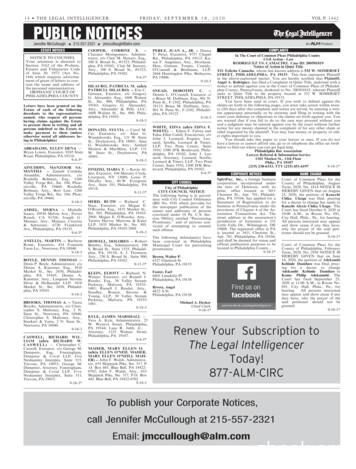Course Title: Reducing Emergency Department Boarding Time, Hospital .
Course Title: Reducing Emergency Department Boarding Time, Hospital Length of Stay, andInpatient Mortality for Hospitalized Patients after Implementation of anElectronic Throughput DashboardDate: June 12, 2019Commercial Support for this activity has been provided by:No commercial support has been provided.Speaker(s) Name: Brandyn Lau, MPH, CPHSpeaker(s) Disclosure information: Please includethe speaker’s relationships as they are listed on theMedStar Financial Disclosure form. If none, write ‘Norelevant financial relationships to report’Talk Title: Reducing Emergency Department BoardingTime, Hospital Length of Stay, and Inpatient Mortalityfor Hospitalized Patients after Implementation of anElectronic Throughput DashboardLearning Objectives:1. Describe the burden of extended boarding hours inthe emergency department.2. Identify barriers to timely throughput from theemergency department to the inpatient setting.3. Assess the effect of a real-time throughputdashboard on emergency department boarding hoursand inpatient mortality.The following Planning Committee members have reportedno relevant financial relationships:Ariana Longley, MPH; David Mayer, MDAccreditationIn support of improving patient care, this activity has been plannedand implemented by MedStar Health and the Patient Safety Network.MedStar Health is jointly accredited by the Accreditation Council forContinuing Medical Education (ACCME), the Accreditation Council forPharmacy Education (ACPE), and the American Nurses CredentialingCenter (ANCC), to provide continuing education for the healthcareteam.Credit DesignationMedStar Health designates this live activity for a maximum of 1.00 AMA PRACategory 1 Credits . Physicians should claim only the credit commensurate withthe extent of their participation in the activity.
Agenda 10 Minutes: Introduction to Patient Safety MovementFoundation and Actionable Patient Safety Solutions(APSS) 40 Minutes: Patient Safety Movement Foundation’sExpert Presentation led by– Brandyn D. Lau, MPH, CPH 10 Minutes: Q & A
Fostering New Efforts and Building On ExistingPatient Safety Programs ThroughCommitments to ZERO
Who Can Take Action? Hospitals & Healthcare Organizations– Make a Commitment Committed Partners– Sign the Commitment to Action letter Healthcare Technology Companies– Sign the Open Data Pledge Patient & Family Advocates– Share their Patient Story, Utilize Resources
Actionable Patient Safety Solutions (APSS)
Impact to Date
Impact to Date*Numbers are based on self-reported data provided by hospitals
Reducing Emergency Department Boarding Time, HospitalLength of Stay, and Inpatient Mortality for Hospitalized Patientsafter Implementation of an Electronic Throughput DashboardBrandyn D. Lau, MPH, CPHAssistant Professor of Radiology and Radiological Science& Health Sciences Informatics, Johns Hopkins School ofMedicineAssociate Faculty, Armstrong Institute for Patient Safetyand Quality
Emergency Department Boarding Boarding in the emergency department (ED) occurs when patients are held in theED after they have been admitted to the hospital until they are physically in aninpatient bed The Joint Commission considers long boarding times to increase health risks forpatients, including delays to receiving care Economic Implications: A 1-hour reduction in ED boarding time could increasedaily revenue by up to 13,000 Longer boarding times have been identified as the main reason for overcrowding inthe ED which have been associated with increased mortality
Emergency Department Boarding In a study of 41k patients admitted through ED, increasing boardingtime was associated with increased mortality (Singer Acad EmergMed 2011)– 2.5% with boarding 2 hours– 4.5% with boarding 12 hours Another study 39k patients admitted through ED, longer boardinghours were associated with higher mortality among non-ICU patients(Reznek Med Care 2018)
National Goals for Boarding Hours The Joint Commission recommends that boarding times average 4hours or less Still, average ED boarding hours have ranged from 2 to 24 hours
Internal Medicine – Johns Hopkins Hospital 570 Full-time faculty 3000 Employees (nurses, fellows, staff) Cardiology, Pulmonary, GI, ID,Endocrine, Renal, Rheumatology, GIM,and Osler Residency Program, etc.
Department ofMedicine 275 open and staffed beds 13,500 inpatient admissions 96,000 outpatient clinic visits13
EmergencyDepartment 35,000 sq. ft.—three times the size of old ED 67 private exam rooms 17-bed emergency acute care unit 6 trauma rooms 8 emergency psychiatry beds Expanded radiology suite—X-Ray, CT, MRI, and ultrasound14
OperatingChallenges No added capacity 30-day readmissions ACGME (Accreditation Council for Graduate Medical Education) Culture of no information Lack of effective communication between teams15
Department of Medicine Demand via the ED 23%u total ED visits result in inpatient admissions 65%u of those admissions come to Internal Medicine The daily patient workflow is affected by ED volumes and the ED relies on Internal Medicine forefficient throughput16
17Bed RequestBed AvailableUnit AssignedED 0Minutes56% of Boarding Time44% of total Boarding Time
18Bed RequestBed AvailableUnit AssignedED 0MinutesBed Wait TimeProcess Time56% of total Boarding Time44% of total Boarding Time56% of Boarding Time44% of total Boarding Time
19Bed Request to Patient Depart Process – Admits from JHH Adult ED only (All Fus)Bed Request(Decision to Admit)If one condition failsProvider?If all conditions metService?Team?Look up unitsPending DischargeDirty BedBed not dirty – pt stillin bedClean BedDirty when requestedBed Clean beforerequestAssign UnitBed DirtyBed Clean afterrequestAssign UnitBed CleanNursing HandOffBed CleanPatient Depart EDProvider Handoff
Static (and Stale) Reports
6/10/1921
6/10/1922Combining Data from Multiple SourcesClinical SystemsOLAP AnalysisADT SystemsETLED SystemsDataWarehouseExtractTransformMeta DataLoadSummary DataReportingRaw DataFlat FilesOR SystemsData Mining
23ExtractExtracts data from thesource systemTransformApply functions toconform data to astandard dimensionalschmeanLoadingLoad the data intodata mart forconsumptionProcessLoad the data fromthe data mart intocube for browsing
6/10/1924Connecting in Real-TimeTravellingAccessAnywhereHomeFrom anydeviceOffice
Dashboard Real-time information regarding current demand and supply A five-stage alert system (heat map) is available to enhance decisionmaking process where the referral source will change its color basedon the volume from green to red. Allows users to identify any patients waiting in emergency departmentfor more than 24 hours, prompting appropriate staff to get updatedstatus on those patients and, if needed, send an internal medicineconsultant to re-evaluate patient and decide further course of action.25
26
%10.97.88.29.010.011.712.090.0%Mean ED Boarding 60.0%2.055.0%50.0%27
gHours vs Occupancy- FY14 YTDthroughJune 4thCorrelation 0.60, P-Value 0.00012Correlation – 0.60P value – 0.000Inflection Point – 211 beds or 84% occupancyBr Hours108642607080Occupancy90100
29Median ED Boarding Hours
Outcomes Median boarding times for internal medicine patients significantlydecreased by 51% (7.9 hours vs. 3.9 hours, p 0.001) Median length of hospitalization significantly decreased by 25% (4days vs. 3 days, p 0.001) Inpatient mortality decreased significantly by 57% (3.5% vs. 1.5%,p 0.001) between the pre- and the full-implementation periods– Inpatient Mortality: 3.5% à 2.1% à 1.5%
Unintended Benefits Identified underlying workflow and staffing issues Predicting bed availability à Pre-assignment
Summary––––Reduced LOS (length of stay)Reduced ED-boarding hour timeChanges to daily hospital operationsEnhanced communication amongst patientcare teams (attendings, nurses, socialworkers, case managers, andadministrators)
Acknowledgements Hetal RupaniSanjay DesaiOmar HarfouchLaura VailAngeline Aringo
Q&A
Save the Dates!Patient Safety E-Newsletter: July 2019 IssueTo be released July 1, 2019Follow our progress!Midyear Planning Meeting: Tuesday, September 17, 2019 World Patient Safety DayBeckman Center of the National Academies of Sciences & Engineering, University of California, Irvine (UCI)Request your invitation today!Next Quarterly Webinar: September 4, 2019Topic: APSS #10: The Advanced Resuscitation Training (ART) System of Care as a Potential Scaffolding forReducing Preventable Death
Thank you!
Electronic Throughput Dashboard Learning Objectives: 1.Describe the burden of extended boarding hours in the emergency department. 2.Identify barriers to timely throughput from the emergency department to the inpatient setting. 3.Assess the effect of a real-time throughput dashboard on emergency department boarding hours and inpatient mortality.
Emergency Nursing), and professional societies (e.g., Society for Academic Emergency Medicine, American College of Emergency Physicians, and Emergency Nurses Association). 3. Section 1. The Need to Address Emergency Department Crowding Many emergency departments (EDs) across the country are crowded. Nearly half of EDs report operating
Title - Lender's Title Policy 535 Title - Settlement Agent Fee 502 Title - Title Search 1,261 Title - Lender's Title Insurance 1,100 Delta Title Inc. Frank Fields 321 Avenue D Anytown, ST 12321 frankf@deltatitle.com 222-444-6666 Title - Other Title Services 1,000 Title - Settlement Agent Fee 350
Customer Service Office 202-354-3600 Response Partners Issue Responsible Office Phone number DC Emergency Concerns DC Homeland Security and Emergency Management (HSEMA) 202 727-6161 Fairfax County Emergency Concerns Fairfax Department of Emergency Management 571-350-1000 Loudoun County Emergency Concerns Loudoun Department of Emergency
UNIT 1: COURSE INTRODUCTION Principles of Emergency Management Page 1.2 How to Complete This Course (Continued) Unit 7: Functions of an Emergency Management Program, presents the core functions of an emergency management program. Unit 8: Applying Emergency Management Principles, provides practice in applying emergency management principles in a problem-solving activity.
Course Title (Cr) Course Title (Cr) Course Title (Cr) Course Title (Cr) Course Title (Cr) SGPA CGPA Results Remarks LG LG LG LG LG 10 FUI/FURC/F-20-BBAH-012 Hamza Imam Baloch English I(3) Islamic Studies(2) Principles of Management(3) Introduction to Computer Application(3) Sociology(3) 1.7 --
Emergency Response Steps, and emergency contact and supply and equipment lists. Figure 10.21: Emergency Contact List (Sample), Figure 10.22: Emergency Vendor and Sources of Assistance List (Sample), and Figure 10.23: Emergency Supplies and Equipment (Sample) The Museum Emergency Planning Cycle (Figure 10.1) provides a visual )
Barb Emergency Physicians Barracuda Emerg Phy Best Care Emergency Phys Bge . Emcare Dtx Emergency Phys Emcare Iah Emerg Physicians Emerald Waters Inpatient Service Emergency Care Associates of Indiana Emergency Center at Timber Ridge Emergency Physician of Nashville Emergency Physicians Inc Excelcare Med Assoc
Austin, TX 78723 Pensamientos Paid Political Announcement by the Candidate Editor & Publisher Alfredo Santos c/s Managing Editors Yleana Santos Kaitlyn Theiss Graphics Juan Gallo Distribution El Team Contributing Writers Wayne Hector Tijerina Marisa Cano La Voz de Austin is a monthly publication. The editorial and business address is P.O. Box 19457 Austin, Texas 78760. The telephone number is .























